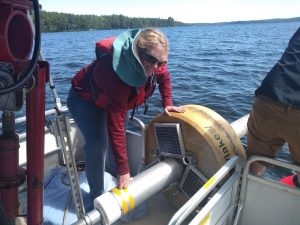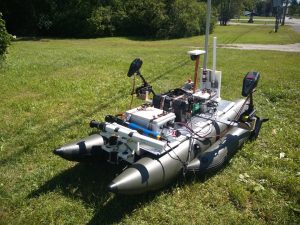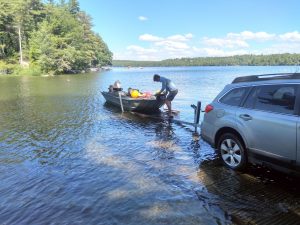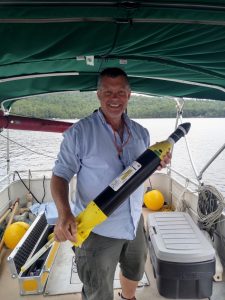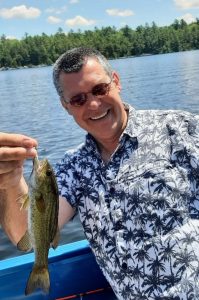RESEARCH VISIT TO 7 LAKES ALLIANCE AND COLBY COLLEGE, MAINE: JAMES RAND
James Rand (Cohort 5, Bath) has recently returned from a one-month research visit to Maine in the United States of America. Find out all about his experience below:
“Hosted by the 7 Lake Alliance (7LA – a watershed organization based in Belgrade Lakes, Maine) and Colby College (a private, undergraduate university in Waterville, Maine) through one of my supervisors (and former University of Bath lecturer) Danielle Wain. I spent a month in Maine conducting experiments, learning the practical craft of lake science, and meeting up with research groups.
Plagued by high wind speeds throughout the trip (causing me to extend the trip by one week), I managed, after several unsuccessful attempts, to conduct my experiments to compare manual WQ sampling from boats with automated methods (both by emulation of autonomous underwater vehicle travel paths and by using an underwater vehicle traveling the same paths). Initial analysis of the results (paper due to be submitted to Limnology and Oceanography: Methods in the next few months) shows that autonomous underwater vehicles can (especially underwater gliders) measure WQ parameters as well as manual WQ sampling but due to them being able to operate over greater spatial and temporal distances (over many kilometers and day+ deployment ranges) they can provide additional data dimensions (an example would potentially be monitoring lake seiches). On one day with increasing wind speeds, we had to stop the experiments and head back in which was lucky for one family out canoeing that we had to rescue. We found them half a kilometer from shore with their Canadian (open) canoe (and not wearing life jackets with wet phones in their pockets) having capsized with no idea how to right it, empty it of water, and get back into it.
Working with a group of summer research students, based in the chemistry department of Colby College, I helped undertake various WQ measurements (something that, as a mechanical engineer on the WISE program, I had up until then only had a vague theoretical knowledge of) as part of a WQ monitoring program and process the samples. Taking light spectrums of water samples that have been turned into a plasma to identify and quantify trace elements was a very cool bit of chemistry that I got involved with. I can now just about fake talking lake science with lake scientists ! Also, some of the prejudices I have built up against Secchi disk readings (based on pandemic era, data analysis trying and failing to link light measurements (PAR) and Secchi disk depth) were challenged, and by undertaking a small experiment, I had to admit that I was wrong.
I also managed to visit and get out with a couple of research groups. Biglow Labs run underwater gliders out across the Gulf of Maine (typical 3-week deployments) to monitor WQ and look at climate change effects. Able to talk to technicians, scientists, and managers, it was a fantastic opportunity to discuss the various ideas that my research to date has generated and clarify my thinking. I also went out with a collaborative research group (Colby, Dartmouth, and Bates Colleges) who have an Autonomous Surface Vehicle (ASV) to monitor surface chlorophyll. This was interesting from looking at the hardware and, by looking through the software, validating that how I have approached my underwater vehicle design is along the same lines.
The planned presentation about my research to the 7 Lake Association community, unfortunately, did not happen (the possibility of an online presentation at a future date remains). However, I attended several lake-side, fund-raising parties (very posh with excellent food and drink) when I was a star attraction (maybe too strong a description !) and told anyone who would listen about my research and its implication for the health of the lake that they were living on. I was also voluntarily ”kidnapped” a few times by people involved as 7LA citizen scientists and taken fishing. Big and small-mouthed bass, pickerel as well as more familiar perch and pike, fantastic fishing. Wildlife was also a big attraction – bald eagles, vultures, kites, beavers, deer, groundhogs, porcupines, red squirrels, etc – really lovely to see.
On the tourism front, I walked some 0.05% of the Appalachian Trail (of 2,200 miles) where I saw a moose which was rather exciting ! I also visited loads of pretty coastal villages. I also visited the sites in Maine associated with the Penobscot Expedition which was the worse maritime defeat (actually caused by internal political squabbling) for America during the War of Independence. I racked up many miles dedicated to tourism over the month (and even wrote 2, without results, papers over 2 weekends) which I very much enjoyed (even if they would not let me into Canada because I was in a hire car). All in all a trip that I gained a lot from with many potential contacts for future work.”
